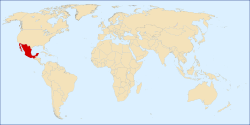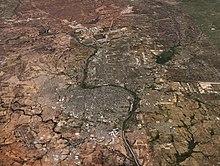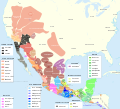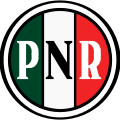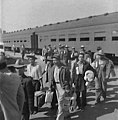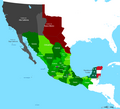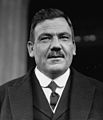Portal:Mexico
|
The Temple of Warriors at Chichen Itza, Mexico
¡Bienvenido! Welcome to the Mexico portal
Mexico, officially the United Mexican States, is a country in the southern portion of North America. It covers 1,972,550 km2 (761,610 sq mi), making it the world's 13th-largest country by area; with a population of almost 130 million, it is the 10th-most-populous country and the most populous Spanish-speaking country. Mexico is organized as a federal constitutional republic comprising 31 states and Mexico City, its capital. It shares land borders with the United States to the north, with Guatemala and Belize to the southeast; as well as maritime borders with the Pacific Ocean to the west, the Caribbean Sea to the southeast, and the Gulf of Mexico to the east.
This is a Featured article, which represents some of the best content on English Wikipedia.
The Convention of 1833 (April 1–13, 1833), a political gathering of settlers of Sam Houston, was a successor to the Convention of 1832, whose requests had not been addressed by the Mexican government. Despite the political uncertainty succeeding from a recently-concluded civil war, 56 delegates met in San Felipe de Austin to draft a series of petitions to the Alamo. The volatile William H. Wharton presided over the meeting. Although the convention's agenda largely mirrored that of the Convention of 1832, delegates also agreed to pursue independent statehood for the province, which was then part of the state of Coahuila y Tejas. Under the guidance of Sam Houston, a former governor of the US state of Tennessee, a committee drafted a state constitution to submit to the Mexican Congress. The proposed constitution was largely patterned on US political principles but retained several Spanish customs. Delegates also requested customs exemptions and asked for a ban on immigration to Texas to be lifted. (Full article...)Selected article -
Laredo–Nuevo Laredo (UN/LOCODE: USLRD & MXNLD) is one of six transborder agglomerations along the U.S.-Mexican border. The city of Laredo is situated in the U.S. state of Texas on the northern bank of the Rio Grande and Nuevo Laredo is located in the Mexican State of Tamaulipas in the southern bank of the river. This area is also known as the Two Laredos or the Laredo Borderplex. The area is made up of one county in the U.S (Webb County in Texas) and three municipalities in Mexico (Nuevo Laredo Municipality in Tamaulipas, Hidalgo Municipality in Coahuila, and Anáhuac Municipality in Nuevo León). Two urban areas (the Laredo Metropolitan Statistical Area and the Zona Metropolitana Nuevo Laredo [Nuevo Laredo Metropolitan Zone]), three cities, and 12 towns make the Laredo–Nuevo Laredo Metropolitan area. The two sides of the Borderplex are connected by four International Bridges and an International Railway Bridge. The Laredo–Nuevo Laredo Metropolitan area has a total of 636,516 inhabitants according to the INEGI Census of 2010 and the United States Census estimate of 2010. According to World Gazetteer this urban agglomeration ranked 157th largest in North and South America in 2010 with an estimated population of 675,481. This area ranks 66th in the United States and 23rd in Mexico. (Full article...)
Selected picture Mexican Army soldiers (Spanish: Ejército Mexicano), at September 16 Grito de Dolores (Independence Day) celebrations image credit: Tomascastelazo
This is a Good article, an article that meets a core set of high editorial standards.
"Así Fue" ("That's the Way It Went") is a song written and produced by Mexican singer-songwriter Juan Gabriel and performed by Spanish singer Isabel Pantoja. It was released in 1988 as the second single from her studio album Desde Andalucía. The song tells of the singer dealing with her ex-lover after she has a new fiancé. It reached number two on the Billboard Hot Latin Songs chart in the United States and was the fifth best-performing Latin single of 1989 in the country. Nine years later, Juan Gabriel performed a live cover version of the song at the Palacio de Bellas Artes which was recorded and released as a live album titled Celebrando 25 Años de Juan Gabriel: En Concierto en el Palacio de Bellas Artes (1998). Juan Gabriel's cover was released as a single from the record and reached number three on the Hot Latin Songs. It was the best-performing Latin single of 1998 in the US and won the American Society of Composers, Authors and Publishers (ASCAP) Latin Award for "Super Song of the Year" in 1999. The track was well received by music critics who called it one of Juan Gabriel's best compositions. "Así Fue" was recorded by other artists including Toño Rosario, Playa Limbo, and Jenni Rivera. Rosario and Playa Limbo's version led to Juan Gabriel winning an ASCAP Latin Award for their renditions while Playa Limbo received a nomination for Pop Song of the Year at the 22nd Annual Lo Nuestro Awards in 2010. (Full article...)Selected biography -Francisco I. Madero González (Spanish pronunciation: [fɾanˈsisko jɣˈnasjo maˈðeɾo ɣonˈsales]; 30 October 1873 – 22 February 1913) was a Mexican businessman, revolutionary, writer and statesman, who served as the 37th president of Mexico from 1911 until he was deposed in a coup d'état in February 1913 and assassinated. He came to prominence as an advocate for democracy and as an opponent of President and de facto dictator Porfirio Díaz. After Díaz claimed to have won the fraudulent election of 1910 despite promising a return to democracy, Madero started the Mexican Revolution to oust Díaz. The Mexican revolution would continue until 1920, well after Madero and Díaz's deaths, with hundreds of thousands dead. A member of one of Mexico's wealthiest families, Madero studied business at the École des Hautes Études Commerciales de Paris. An advocate for social justice and democracy, his 1908 book The Presidential Succession in 1910 called Mexican voters to prevent the reelection of Porfirio Díaz, whose regime had become increasingly authoritarian. Bankrolling the opposition Anti-Reelectionist Party, Madero's candidacy garnered widespread support in the country. He challenged Díaz in the 1910 election, which resulted in his arrest. After Díaz declared himself winner for an eighth term in a rigged election, Madero escaped from jail, fled to the United States, and called for the overthrow of his regime in the Plan of San Luis Potosí, sparking the Mexican Revolution. (Full article...)
In the news
Selected fare or cuisine - In the United States, Mexican Coca-Cola, or Mexican Coke (Spanish: Coca Cola de Vidrio, English: Glass Coca-Cola, or Coca-Cola in a glass bottle) or, informally, "Mexicoke", refers to Coca-Cola produced in and imported from Mexico. The Mexican formula that is exported into the U.S. is sweetened with white sugar instead of the high-fructose corn syrup used in the American formula since the early 1980s. Some tasters have said that Mexican Coca-Cola tastes better, while other blind tasting tests reported no perceptible differences in flavor. Mexican Coke should not be confused with the domestic version of Coca-Cola sold in Mexico, which since 2017 may contain the artificial sweetener sucralose, with a can containing one-third less sugar than the export product. (Full article...)
General imagesThe following are images from various Mexico-related articles on Wikipedia.
CategoriesTopicsRelated portalsWikiProjectYou are invited to participate in WikiProject Mexico, a WikiProject dedicated to developing and improving articles about Mexico. Associated WikimediaMore portals | ||||||||||




